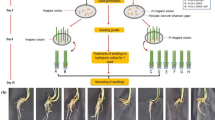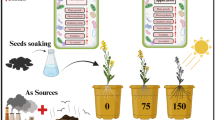Abstract
Carbon nanoparticles attract attention of plant researchers as a possible means of improving crop yield and its quality. There are grounds to believe that the beneficial influence of polyhydroxy fullerene (PHF) on plants is due to its antioxidant activity, but the mechanism of its action on their growth and development remains unclear. Our study shows that PHF added to the nutrient medium accelerates barley roots elongation owing to the increase of their longitudinal extensibility in the growth zone. The impact of PHF on root growth was much more pronounced under the action of stressors inducing the accumulation of reactive oxygen species, such as UV-B radiation, salt stress and the excess of salicylic acid. Dichlorofluorescein assay showed that PHF prevented oxidative stress development and subapical root swelling after UV-B irradiation of roots. The conclusion is drawn that the important reason of root growth acceleration in the presence of PHF is its ability to serve as a scavenger of free radicals. That’s why it may be especially useful for the improvement of plant growth under environmental stress.



Similar content being viewed by others

References
Andreev I, Petrukhina A, Garmanova A, Babakhin A, Andreev S, Romanova V, Troshin P, Troshina O, DuBuske L (2008) Penetration of fullerene C60 derivatives through biological membranes. Fuller Nanotub Carbon Nanostruct 16:89–102
Aslani F, Bagheri S, Julkapli NM, Juraimi ASh, Hashemi FSG, Baghdadi A (2014) Effects of engineered nanomaterials on plants growth. Sci World J ID. doi:10.1155/2014/641759
Bennett MD, Finch RA (1972) The mitotic cycle time of root meristem cells of Hordeum vulgare. Caryologia Int J Cytol Cytosyst Cytogen 25:439–444
Caldwell MM (1981) Plant response to solar ultraviolet radiation. In: Lange OL et al (eds) Encyclopedia of plant physiology, physiological plant ecology 1: Responses to the Physical Environment, vol 12A. Springer, Heidelberg, pp 169–197
Chen Z, Silva H, Klessig DF (1993) Active oxygen species in the induction of plant systemic acquired resistance by salicylic acid. Science 262:1883–1886
Chen R, Ratnikova TA, Stone MB, Lin S, Lard M, Huang G, Hudson JS, Ke PC (2010) Differential uptake of carbon nanoparticles by plant and mammalian cells. Small 6:612–617
Cosgrove DJ (1997) Relaxation in a high-stress environment: the molecular basis of extensible cell walls and cell enlargement. Plant Cell 9:1031–1041
De Cnodder T, Vissenberg K, Van Der Straeten D, Verbelen JP (2005) Regulation of cell length in the Arabidopsis thaliana root by the ethylene precursor 1-aminocyclopropane-1-carboxylic acid: a matter of apoplastic reactions. New Phytol 168:541–550
de Vries H (1877) Untersuchungen über die mechanischen Ursachen der Zellstreckung, ausgehend von der Einwirkung von Salzlösungen auf den Turgor wachsender Pflanzenzellen. Wilhelm Engelmann, Leipzig
Dugan LL, Turetsky DM, Du C, Lobner D, Wheeler M, Almli CR, Shen CK-F, Luh T-Y, Choi DW, Lin T-S (1997) Carboxyfullerenes as neuroprotective agents. Proc Natl Acad Sci USA 94:9434–9439
Dugan LL, Lovett EG, Quick KL, Lotharius J, Lin TT, O’Malley KL (2001) Fullerene-based antioxidants and neurodegenerative disorders. Parkinsonism Relat Disord 7:243–246
Durner J, Klessig DF (1995) Inhibition of ascorbate peroxidase by salicylic acid and 2,6-dichloroisonicotinic acid, two inducers of plant defense responses. Proc Natl Acad Sci USA 92:11312–11316
Frohnmeyer H, Staiger D (2003) Ultraviolet-B radiation-meditated responses in plants. Balancing Damage and protection. Plant Physiol 133:1420–1428
Gao J, Wang Y, Folta KM, Krishna V, Bai W, Ingeglia P, Georgieva A, Nakamura H, Koopman B, Moudgil B (2011) Polyhydroxy fullerenes (PHFs or fullerenols): beneficial effects on growth and lifespan in diverse biological models. PLoS ONE 6(5):e19976. doi:10.1371/journal.pone.0019976
Gharbi N, Pressac M, Hadchouel M, Szwarc H, Wilson SR, Moussa F (2005) Fullerene is a powerful antioxidant in vivo with no acute or subacute toxicity. Nano Lett 5:2578–2585
Grzesiak M, Filek M, Barbasz A, Kreczmer B, Hartikainen H (2013) Relationships between polyamines, ethylene, osmoprotectants and antioxidant enzymes activities in wheat seedlings after short-term PEG- and NaCl-induced stresses. Plant Growth Regul 69:177–189. doi:10.1007/s10725-012-9760-9
Husen A, Siddigi KS (2014) Carbon and fullerene nanomaterials in plant system. J Nanobiotechnol 12:16–26
Ivanov VB (2011) Using the roots as test objects for the assessment of biological action of chemical substances. Russ J Plant Physiol 58:1082–1089
Janicka-Russak M, Kabała K, Wdowikowska A, Kłobus G (2013) Modification of plasma membrane proton pumps in cucumber roots as an adaptation mechanism to salt stress. J Plant Physiol 170:915–922
Johansson I, Karisson M, Shulka VK, Chrispeels MJ, Larsson C, Kjellbom P (1998) Water transport activity of the plasma memrane aquaporin PM28A is regulated by puosphorylation. Plant Cell 10:451–459
Khodakovskaya M, Dervishi E, Mahmood M, Yang X, Li Z, Fumiya W, Biris A (2009) Carbon nanotubes are able to penetrate plant seed coat and dramatically affect seed germination and plant growth. ACS Nano 3:3221–3227
Kole C, Kole P, Randunu KM, Choudhary P, Podila R, Ke PC, Rao AM, Marcus RK (2013) Nanobiotechnology can boost crop production and quality: first evidence from increased plant biomass, fruit yield and phytomedicine content in bitter melon (Momordica charantia). BMC Biotechnol 13:37–58
Ktitorova IN, Skobeleva OV, Sharova EI, Ermakov EI (2002) Hydrogen peroxide appears to mediate a decrease in hydraulic conductivity in wheat roots under salt stress. Russ J Plant Physiol 49:369–380
Ktitorova IN, Skobeleva OV, Kanash EV, Bilova TE, Sharova EI (2006a) Causes of root growth retardation induced by ultraviolet-B irradiation of shoots of barley seedlings. Russ J Plant Physiol 53:85–95
Ktitorova IN, Demchenko NP, Kalimova IB, Demchenko KN, Skobeleva OV (2006b) Cellular analysis of UV-B-induced barley root subapical swelling. Russ J Plant Physiol 53:824–836
Ktitorova IN, Skobeleva OV, Agaltsov KG (2012) Biophysical parameters as informative tools for elucidating the causes of root growth retardation under stressful conditions. Russ J Plant Physiol 59:118–126
Kvaratskhelia M, George SJ, Thorneley RN (1997) Salicylic acid is a reducing substrate and not an effective inhibitor of ascorbate peroxidase. J Biol Chem 272:20998–21001
Lawaczek R, Fitterich H (1988) Pathways of water through erythrocyte membranes. Routes along defect structures. J Theor Biol 135:401–407
Maurel C (1997) Aquaporins and water permeability of plant membranes. Annu Rev Plant Physiol Plant Mol Biol 48:399–429
Mori IC, Schroeder JI (2004) Reactive Oxygen Species Activation of Plant Ca2+ Channels. A signalling mechanism in polar growth, hormon transduction, stress signalling, and hypothetically mechanotransduction. Plant Physiol 135:702–708
Nair R, Varghese SH, Nair BG, Maekawa T, Yoshida Y, Kumar DS (2010) Nanoparticulate material delivery to plants. Plant Sci 179:154–163
Naydov IA, Mudrik VA, Ivanov BN (2010) Light-induced hydrogen peroxide dynamics in protoplasts from leaves of both wild-type Arabidopsis and its mutant deficient in ascorbate biosynthesis. Dokl Biochem Biophys 432:137–140
Neumann PM (1995) Inhibition of root growth by salinity stress: toxicity or an adaptive biophysical response? In: Baluška F et al (eds) Structure and function of roots. Kluwer Academic Publishers, Dordrecht, pp 299–304
Peters WS, Farm MS, Kopf AJ (2001) Does growth correlate with turgor-induced elastic strain in stems? a reevaluation of de Vries’ classical experiments. Plant Physiol 125:2173–2179
Piotrovsky LB, Eropkin MYu, Eropkina EM, Dumpis MA, Kiselev OI (2007) Mechanisms of biologic action of fullerenes—dependence on aggregate state. Psychopharmacol Biol Narcol 7:1548–1554
Rao MV, Davis KR (1999) Ozone-induced cell death occurs via two distinct mechanisms in Arabidopsis: the role of salicylic acid. Plant J 17:603–614
Rico CM, Majumdar S, Duarte-Gardea M, Peralta-Videa JR, Gardea-Torresdey JL (2011) Interaction of nanoparticles with edible plants and their possible implications in the food chain. J Agric Food Chem 59:3485–3498
Rivas-San Vicente M, Plasencia J (2011) Salicylic acid beyond defence: its role in plant growth and development. J Exp Bot 62:3321–3338. doi:10.1093/jxb/err031
Schopfer P, Plachy C, Frahry G (2001) Release of reactive oxygen intermediates (superoxide radicals, hydrogen peroxide, and hydroxyl radicals) and peroxidase in germinating radish seeds controlled by light, gibberellin, and abscisic acid. Plant Physiol 125:1591–1602
Scott IM, Clarke SM, Wood JE, Mur LA (2004) Salicylate accumulation inhibits growth at chilling temperature in Arabidopsis. Plant Physiol 135:1040–1049. doi:10.1104/pp.104.041293
Semenov KN, Charykov NA, Keskinov VN (2011) Fullerenol synthesis and identification. Properties of the fullerenol water solutions. J Chem Eng Data 56:230–239
Shalata A, Neumann PM (2001) Exogenous ascorbic acid (vitamin C) increases resistance to salt stress and reduces lipid peroxidation. J Exp Bot 52:2207–2211
Shim IS, Momose Y, Yamamoto A, Kim DW, Usui K (2003) Inhibition of catalase activity by oxidative stress and its relationship to salicylic acid accumulation in plants. Plant Growth Regul 39:285–292
Sivaguru M, Pike Sh, Gassmann W, Baskin TI (2003) Aluminium rapidly depolymerizes cortical microtubules and depolarizes the plasma membrane: evidence that these responses are mediated by a glutamate receptor. Plant Cell Physiol 44:667–675
Skobeleva OV, Ktitorova IN, Agal’tsov KG (2011) The causes for barley root growth retardation in the presence of ammonium and glutamate. Russ J Plant Physiol 58:307–315
Takahashi H, Kawahara A, Inoue Y (2003) Ethylene promotes the induction by auxin of the cortical microtubule randomization required for low-pH-induced root hair initiation in lettuce (Lactica sativa L.) seedlings. Plant Cell Physiol 44:932–940
Xu S, Hu J, Li Y, Ma W, Zheng Y, Zhu S (2011) Chilling tolerance in Nicotiana tabacum induced by seed priming with putrescine. Plant Growth Regul 63:279–290
Yin JJ, Lao F, Vehg J, Fu PP, Zhao YL et al (2008) Inhibition of tumor growth by endohedral metallofullerenol nanoparticles optimized as reactive oxygen species scavenger. Mol Pharmacol 74:1132–1140
Zha YY, Yang B, Tang ML, Guo QC, Chen JT, Wen LP, Wang M (2012) Concentration-dependent effects of fullerenol on cultured hippocampal neuron viability. Int J Nanomed 7:3099–3109. doi:10.2147/IJN.S30934
Author information
Authors and Affiliations
Corresponding author
Rights and permissions
About this article
Cite this article
Panova, G.G., Ktitorova, I.N., Skobeleva, O.V. et al. Impact of polyhydroxy fullerene (fullerol or fullerenol) on growth and biophysical characteristics of barley seedlings in favourable and stressful conditions. Plant Growth Regul 79, 309–317 (2016). https://doi.org/10.1007/s10725-015-0135-x
Received:
Accepted:
Published:
Issue Date:
DOI: https://doi.org/10.1007/s10725-015-0135-x



